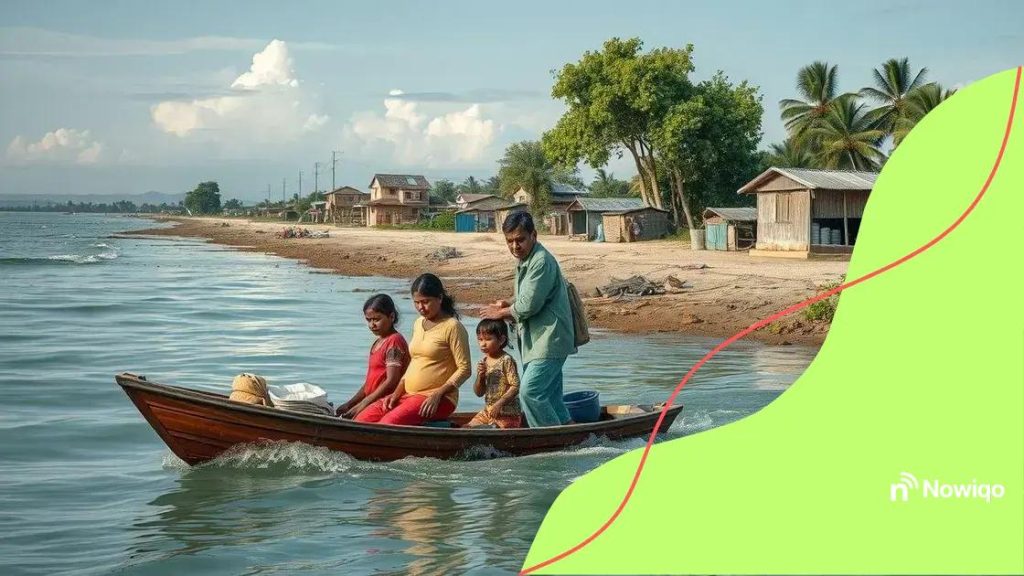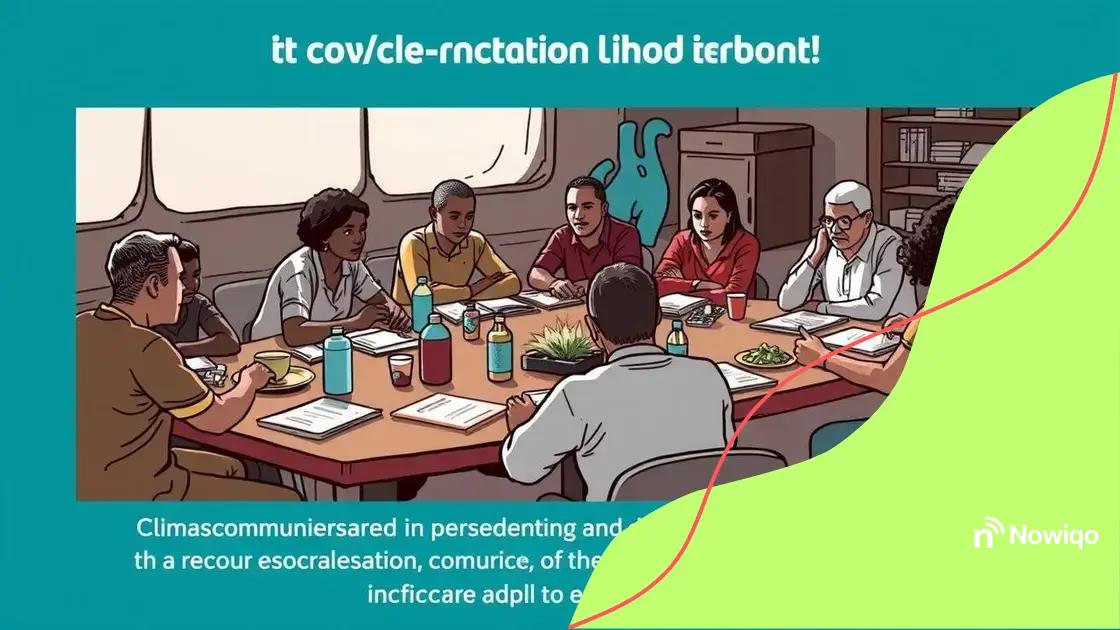U.S. faces internal migration from climate change

Anúncios
The U.S. faces internal migration from climate change as people relocate due to worsening environmental conditions, including rising sea levels, extreme weather events, and droughts, affecting communities and urban centers significantly.
As U.S. faces internal migration from climate change, many wonder how these shifts are reshaping our landscapes and communities. Have you thought about how these changes might affect you?
Anúncios
Understanding climate change effects on migration
Understanding the effects of climate change on migration is crucial. As our planet warms, many regions experience extreme weather, making them less habitable. People are starting to move in search of better, safer environments. This internal migration is reshaping communities across the U.S.
Impact on Vulnerable Areas
Coastal areas are particularly vulnerable to climate change. Rising sea levels increase the risk of flooding, while hurricanes become more severe. As a result, many families are forced to leave their homes.
Key Reasons for Migration
- Increased natural disasters like wildfires and hurricanes.
- Decreased agricultural productivity due to changing weather patterns.
- Water scarcity in regions increasingly affected by drought.
- Economic instability stemming from climate impacts.
These factors not only affect individuals but also disrupt local economies and social structures. Additionally, as more people leave their homes, communities adapt to these changes, often struggling to provide support and resources for newcomers.
Anúncios
Case Studies of Affected Regions
In places like California, wildfires have prompted many to seek refuge in neighboring states. Similarly, areas in the Midwest are experiencing shifts in population as farmers deal with erratic weather. These movements are often fueled by a desire for security and a better quality of life.
While migration may provide relief from the immediate effects of climate change, it also presents new challenges. Schools, healthcare, and housing in receiving areas often face increased pressure as the population grows. Understanding these dynamics is essential for policy-makers and communities alike.
As we navigate these changes, recognizing the drivers of internal migration will help us build more resilient societies that can adapt to an uncertain future.
Regions most affected by climate migration
Regions most affected by climate migration are witnessing significant changes. Many areas are grappling with the impact of climate events, which force individuals and families to reconsider their living situations. Understanding where these changes are happening can help us prepare for future migrations.
Key Affected Areas
Coastal communities are often the first to feel the effects. Places like Florida and Louisiana face rising sea levels, leading to flooding and erosion. As homes and infrastructure become compromised, residents seek safer areas.
Midwest Challenges
In the Midwest, farmers confront altered precipitation patterns and increased droughts. This situation diminishes agricultural productivity, leading many to migrate to urban centers. Areas that once thrived are now struggling to adapt.
- Regions experiencing drought.
- Flood-prone coastal areas.
- Urban centers receiving new populations.
- Small towns losing residents to bigger cities.
Furthermore, cities like Chicago and Detroit are becoming hotspots for migration due to their relatively stable climates and job opportunities. However, the influx of new residents puts pressure on housing and social services, creating both challenges and opportunities.
Patterns of Movement
It’s important to recognize how these migrations work. As natural disasters strike, they prompt immediate evacuations. Over time, some people stay in their new locations, while others return to rebuild. This cycle of migration reflects the urgency of adapting to climate-related changes.
In addition to environmental factors, economic incentives drive migration. Residents move in search of better jobs or quality of life, influenced by what their home regions can no longer provide.
Community responses to climate-induced relocation

Community responses to climate-induced relocation play a crucial role in how effectively societies adapt to changing circumstances. As people are forced to leave their homes due to climate events, local governments and organizations are stepping up to provide support. Understanding these responses can help us see the resilience of affected communities.
Local Government Initiatives
Local governments often implement plans to assist residents impacted by climate relocation. Many develop emergency services and resources to help people transition smoothly. This includes providing access to temporary housing and essential services.
Supportive Community Organizations
Community organizations also play a vital role. Non-profits often provide resources like food and medical assistance. They help residents secure new jobs or support them with legal advice on housing rights. By forming partnerships, these organizations can strengthen community ties and build resilience among displaced populations.
- Emergency shelters established during disasters.
- Job training programs for displaced individuals.
- Access to mental health resources.
- Legal aid for housing and relocation issues.
Grassroots initiatives emerge in response to the needs of displaced individuals. Neighbors often come together to assist each other, sharing resources and information. This suggests an innate drive within communities to support one another in times of crisis.
Adaptation Strategies
Some communities are proactively developing adaptation strategies to prepare for future climate impacts. These plans may include investing in green infrastructure, promoting sustainable practices, and engaging residents in decision-making. By empowering community voices, these strategies can lead to more tailored responses to local needs.
Education also plays a crucial role in equipping residents with the knowledge to respond to ongoing climate challenges. Workshops and community meetings can foster understanding and awareness of climate issues, allowing for better planning and cooperation.
Policies addressing internal migration due to climate
Policies addressing internal migration due to climate change are increasingly necessary as communities face the realities of environmental shifts. Governments are beginning to recognize the need for thoughtful frameworks that not only respond to immediate needs but also anticipate future challenges.
Developing Supportive Frameworks
Many local and state governments are crafting policies to support populations affected by climate displacement. These policies focus on providing assistance in various forms. For example, funds may be allocated to assist with housing transitions, offer financial aid, or develop programs that help people find new employment.
Collaboration among Agencies
Collaboration among different government agencies is essential. Environmental, housing, and social services must work together to create a comprehensive response. By aligning their goals, they can ensure that resources are used efficiently and effectively.
- Coordinated emergency response teams during climate events.
- Infrastructure improvements in at-risk areas.
- Community education initiatives about climate risks.
- Financial support for low-income families relocating.
In addition to government efforts, non-profit organizations can also play a vital role in shaping these policies. By providing insights and data on the needs of displaced populations, they can help inform decision-makers.
Long-term Strategies
Long-term strategies are crucial. Policymakers are beginning to consider how to make communities more resilient to climate change, reducing the need for future migrations. This can include investing in sustainable infrastructure and improving environmental protections that mitigate climate impacts.
Ultimately, addressing the effects of climate change on internal migration requires a comprehensive approach. By thinking ahead and developing adaptable policies, communities can better navigate this evolving challenge. The goal is to create a framework that supports both current and future needs while fostering community resilience.
Future outlook on internal migration patterns
The future outlook on internal migration patterns reveals significant shifts due to climate change. As environmental factors continue to evolve, so do the movements of people within the United States. Recognizing these patterns helps communities and policymakers plan effectively.
Emerging Migration Trends
Several trends are becoming evident. For example, more individuals are moving from coastal areas to inland regions as sea levels rise and storms become more aggressive. This trend shows an urgency for safe living conditions.
Urbanization and Migration
At the same time, urban areas are attracting a growing number of residents. As rural areas face increasing challenges from climate impacts, people often migrate to cities in search of better jobs and resources. Urban centers may see population surges, leading to both opportunities and challenges.
- Increased housing demands in urban areas.
- Strain on local services and infrastructure.
- Opportunities for economic growth in new regions.
- Emergence of diverse communities as populations mix.
Furthermore, migration patterns are influenced by climate-related disasters. Areas hit by wildfires or floods may experience temporary migrations, while some may choose to resettle permanently. This constant movement impacts local economies and social dynamics.
Adaptation Strategies for the Future
To address these changes, communities need to develop adaptive strategies. This can involve creating more sustainable infrastructure, offering relocation assistance, and ensuring job availability in both urban and rural areas. By anticipating future challenges, societies can better prepare for the shifts in population.
Keeping an eye on these emerging internal migration patterns allows us to understand the pressing social issues and implement proactive measures. The goal is to create resilient communities that can thrive despite the challenges posed by climate change.
FAQ – Frequently Asked Questions About Internal Migration Due to Climate Change
What are the main causes of internal migration due to climate change?
The main causes include rising sea levels, extreme weather events, droughts, and natural disasters that make certain regions uninhabitable.
How does climate change impact urban areas?
Climate change increases pressure on urban areas as they receive more migrants seeking safety and better opportunities, leading to potential overcrowding and resource strain.
What support can communities provide for displaced individuals?
Communities can provide financial assistance, job training programs, emergency housing, and mental health resources to help those displaced by climate change.
How can policymakers prepare for future migration patterns?
Policymakers can conduct research on emerging trends, create adaptive strategies, and invest in sustainable infrastructure to better accommodate future migrations.